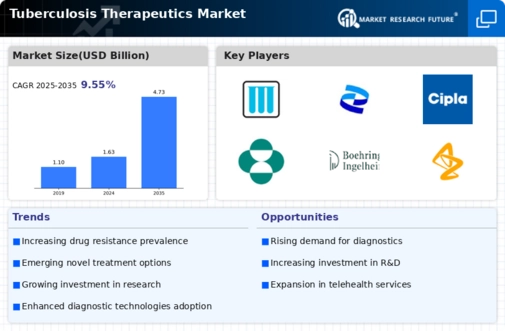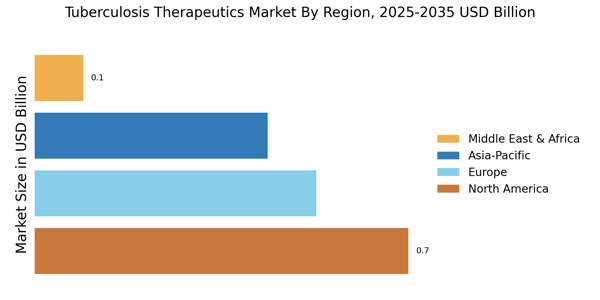Rising Awareness and Education
Rising awareness and education regarding tuberculosis are pivotal drivers for the Tuberculosis Therapeutics Market. Public health campaigns aimed at educating communities about TB symptoms, transmission, and treatment options are gaining momentum. Increased awareness leads to early diagnosis and treatment, which is essential for controlling the spread of the disease. Healthcare providers are also receiving enhanced training to recognize and manage TB cases effectively. This growing emphasis on education is likely to result in higher demand for TB therapeutics as more individuals seek treatment. Additionally, partnerships between governments, NGOs, and healthcare organizations are fostering community engagement and outreach efforts. As awareness continues to rise, the Tuberculosis Therapeutics Market is expected to experience increased utilization of available therapies, ultimately contributing to better health outcomes.
Advancements in Drug Development
Recent advancements in drug development are significantly influencing the Tuberculosis Therapeutics Market. The introduction of novel therapeutics, such as bedaquiline and delamanid, has transformed treatment protocols, offering new hope for patients with multidrug-resistant TB. These innovations not only improve treatment outcomes but also address the urgent need for effective therapies in the face of rising drug resistance. The market is witnessing a shift towards combination therapies that enhance efficacy and reduce treatment duration. Furthermore, ongoing clinical trials and research initiatives are likely to yield additional therapeutic options, thereby expanding the market. The collaboration between public and private sectors in funding research initiatives is expected to accelerate the pace of drug development, ultimately benefiting the Tuberculosis Therapeutics Market and improving patient care.
Government Initiatives and Funding
Government initiatives and funding play a crucial role in shaping the Tuberculosis Therapeutics Market. Various countries have implemented national TB control programs aimed at reducing the burden of the disease. These initiatives often include financial support for research, development, and distribution of TB therapeutics. For instance, increased funding from governmental and non-governmental organizations has been directed towards innovative treatment strategies and public health campaigns. Such investments are essential for enhancing access to effective therapies, particularly in regions with high TB prevalence. The commitment of governments to combat TB through policy frameworks and funding allocations is likely to foster a conducive environment for market growth. As a result, the Tuberculosis Therapeutics Market is expected to benefit from sustained governmental support, leading to improved health outcomes and reduced transmission rates.
Increase in Tuberculosis Incidence Rates
The rising incidence rates of tuberculosis (TB) are a primary driver for the Tuberculosis Therapeutics Market. According to the World Health Organization, there were approximately 10 million new TB cases reported in recent years, indicating a persistent public health challenge. This surge in cases necessitates the development and distribution of effective therapeutics, thereby stimulating market growth. The increasing prevalence of TB, particularly in low- and middle-income countries, underscores the urgent need for innovative treatment options. As healthcare systems strive to combat this infectious disease, investments in research and development are likely to rise, further propelling the Tuberculosis Therapeutics Market. The focus on improving treatment regimens and reducing the duration of therapy is expected to attract significant attention from pharmaceutical companies, enhancing the overall market landscape.
Emergence of Telemedicine in TB Management
The emergence of telemedicine is transforming the landscape of TB management, serving as a significant driver for the Tuberculosis Therapeutics Market. Telehealth services facilitate remote consultations, enabling healthcare providers to monitor patients and manage treatment regimens effectively. This approach is particularly beneficial in regions with limited access to healthcare facilities, ensuring that patients receive timely care. The integration of telemedicine into TB management strategies is likely to enhance adherence to treatment protocols, thereby improving patient outcomes. Furthermore, telemedicine can facilitate the collection of data on treatment efficacy and patient experiences, informing future therapeutic developments. As healthcare systems increasingly adopt digital health solutions, the Tuberculosis Therapeutics Market is poised to benefit from the enhanced accessibility and efficiency of TB care.


















Leave a Comment